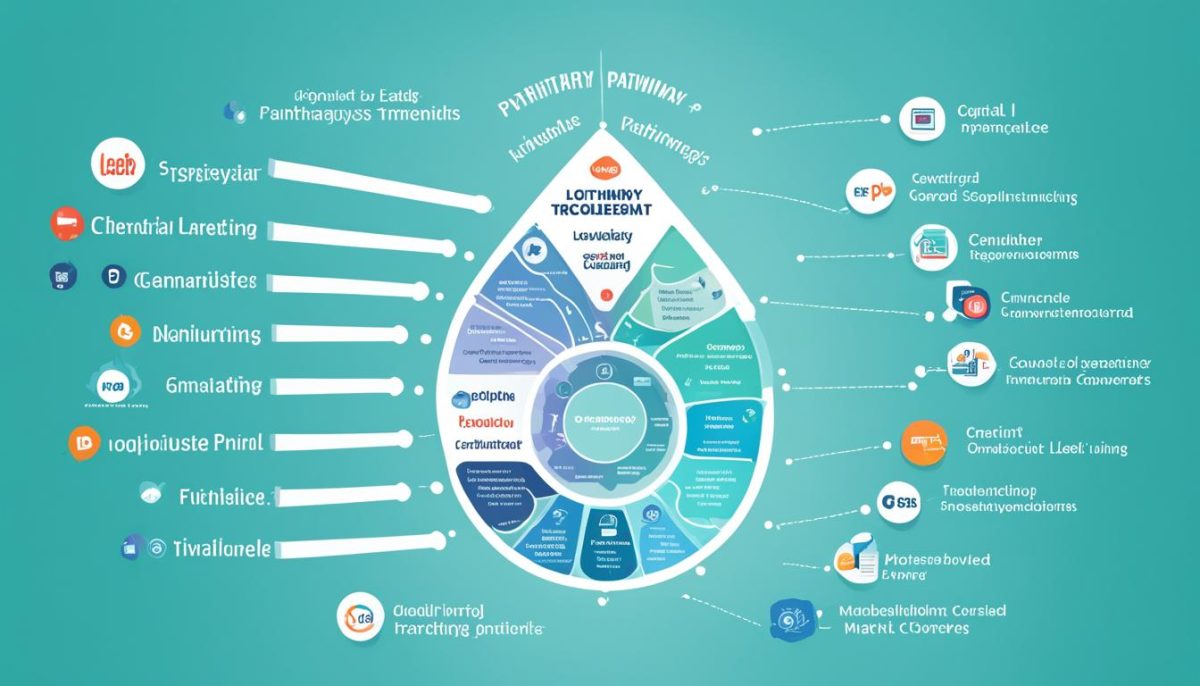Welcome to our guide on generating leads in the realm of digital marketing. In today’s digital age, where competition is fierce and attention spans are short, businesses need to deploy effective strategies to capture potential customers and convert them into valuable leads. In this article, we will explore the various techniques and tactics that can help businesses thrive in the digital landscape.
As digital marketing continues to gain significance in the business world, understanding how to generate leads has become crucial. Generating leads refers to the process of attracting and nurturing potential customers, ultimately leading them to make a desired action, such as making a purchase or signing up for a service.
By leveraging the power of digital marketing, businesses can reach their target audience more effectively, generate high-quality leads, and achieve their sales objectives. Whether you are a small startup or a well-established organization, this guide will provide you with actionable insights to generate leads using the power of digital marketing.
Throughout this guide, we will explore different aspects of lead generation in digital marketing, including the key metrics to measure success, the role of various channels, and effective strategies to implement. By understanding these concepts and applying the recommended strategies, you will be well-equipped to drive success and achieve your lead generation goals.
Understanding Lead Generation in Digital Marketing
In the world of digital marketing, lead generation plays a crucial role in driving business growth and success. But what exactly is lead generation, and how does it work in the digital landscape?
Lead generation, in simple terms, refers to the process of capturing and cultivating potential customers’ interest in your products or services. These potential customers, known as leads, provide their contact information in exchange for valuable content, offers, or resources that your business provides.
There are different types of leads that businesses can generate, including:
- Marketing Qualified Leads (MQLs): These leads have shown interest in your brand through marketing efforts but may not be ready to make a purchase yet.
- Sales Qualified Leads (SQLs): These leads have shown a higher level of interest, indicating they are more likely to convert into paying customers.
- Product Qualified Leads (PQLs): These leads have interacted with your product or service and demonstrated a strong interest in becoming a customer.
Now, let’s dive into the lead generation funnel, which outlines the stages a lead goes through before becoming a customer:
- Awareness: At this stage, potential leads become aware of your brand and what you offer. They may come across your website, social media posts, or other digital marketing efforts.
- Interest and Evaluation: Once aware, leads show interest in your offerings and start evaluating whether your solution could address their needs or solve their problems.
- Conversion: In the final stage, leads make a decision to convert into customers by taking the desired action, such as making a purchase or requesting more information.
To measure the success of lead generation campaigns, it’s essential to track key metrics, such as:
- Conversion rates: The percentage of leads that take the desired action and convert into customers.
- Cost per lead: The average cost incurred to generate each lead.
- Lead quality: The level of interest and likelihood of conversion exhibited by leads.
Digital marketing channels play a vital role in driving lead generation. Let’s explore how different digital marketing channels contribute to lead generation:
- SEO (Search Engine Optimization): Optimizing your website and content for search engines helps you attract organic traffic and generate high-quality leads.
- Social Media: Leveraging social media platforms allows you to engage with your target audience, build brand awareness, and drive leads through targeted campaigns.
- Content Marketing: Creating valuable and educational content attracts and nurtures leads, positioning your brand as a trusted authority in your industry.
- Paid Advertising: Running targeted ads on platforms like Google Ads and social media networks enables you to reach a wider audience and generate leads through specific targeting criteria.
Understanding lead generation in digital marketing is the first step towards implementing effective strategies to drive business growth. In the next section, we will explore practical techniques and strategies to generate leads in the digital landscape.
Strategies to Generate Leads in Digital Marketing
When it comes to digital marketing, having effective strategies to generate leads is crucial for the success of any business or brand. In this section, we will explore practical tactics and techniques that can help you generate high-quality leads and drive growth.
Lead Magnet Creation
A lead magnet is a valuable piece of content or resource that you offer to your target audience in exchange for their contact information. It could be an e-book, a whitepaper, a webinar, or a free tool. By creating compelling lead magnets, you can attract potential customers and capture their details, enabling you to nurture them into paying customers later on.
Optimizing Landing Pages
Your landing pages play a critical role in converting visitors into leads. By optimizing your landing pages with persuasive copy, clear call-to-action buttons, and relevant visuals, you can enhance user experience and entice visitors to take the desired action, such as filling out a form or subscribing to your newsletter. Remember, a well-designed and user-friendly landing page can significantly increase your lead generation efforts.
Using Email Marketing Campaigns
Email marketing remains one of the most effective strategies for lead generation. By building a targeted email list, you can communicate directly with your prospects and nurture them through personalized and relevant content. Use email automation tools to segment your audience and send tailored messages based on their preferences and behavior.
Leveraging Social Media Platforms
Social media platforms offer a great opportunity to generate leads and engage with your audience. Create compelling content that resonates with your target market and drives them to take action. Use lead generation forms and call-to-action buttons on your social media profiles to capture leads directly within the platform.
Running Targeted Ads
Running targeted ads on platforms like Google Ads, Facebook Ads, and LinkedIn Ads can help you reach your ideal customers and generate leads. Use advanced targeting options to define your audience based on demographics, interests, and online behavior. Craft compelling ad copy and design visually appealing creatives to capture attention and encourage clicks.
Utilizing Marketing Automation Tools
Marketing automation tools can streamline your lead generation efforts and help you nurture leads at scale. Use automation workflows to send personalized follow-up emails, automate lead scoring and segmentation, and track the effectiveness of your campaigns. By leveraging the power of automation, you can save time, increase efficiency, and generate more leads.
Implementing these proven strategies can significantly boost your lead generation efforts in digital marketing. Remember to continuously monitor and optimize your campaigns, experimenting with different tactics to find what works best for your specific business and target audience.

Measuring and Improving Lead Generation Performance
Measuring the effectiveness of your lead generation efforts is essential for optimizing results and achieving success in digital marketing. In this section, we will explore various methods and strategies that will help you measure and improve your lead generation performance.
To start, setting up conversion tracking is crucial. By tracking conversions, you can gain valuable insights into which marketing channels, campaigns, or tactics are driving the most leads. This allows you to allocate your resources effectively and focus on what works best for your business.
Another powerful tool for measuring lead generation performance is analytics. Implementing analytics tools such as Google Analytics enables you to track the behavior of your website visitors. You can analyze user engagement, identify high-performing landing pages, and uncover opportunities for optimization.
In addition, conducting A/B testing is a valuable method for improving performance. By testing different variations of your landing pages and calls to action, you can identify the most effective elements that drive conversions. Continuous testing and optimization will ensure that your lead generation efforts are always improving and delivering the best possible results.

